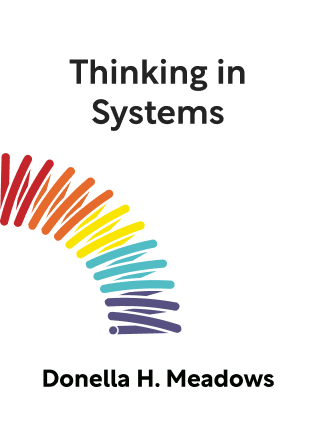

This article is an excerpt from the Shortform summary of "Thinking in Systems" by Donella H. Meadows. Shortform has the world's best summaries of books you should be reading.
Like this article? Sign up for a free trial here .
What is the systems thinking model? What is a system and how can the systems thinking model build systems that work?
The systems thinking model encourages you to think about all structures—business, social, government—as systems that can be organized to work properly an efficiently.
Keep reading to found out more about the systems thinking model.
What Is the Systems Thinking Model?
The systems thinking model is composed of three things:
- Elements: The individual things in the system
- Interconnections: The relationships between the elements
- Purpose or Function: What the system achieves
To define it more cohesively, a system is a set of elements that is interconnected in a way that achieves its function.
Many things in the world operate as systems.
- A football team consists of a group of players on the field, each with a specific role that interacts with the others. The larger team system also consists of coaches, support staff, and fans.
- Within the system of a corporation, people, machines, and information work together to achieve the corporation’s goals. This corporation then takes place within the larger system of the economy.
Stocks and Flows
Stocks and flows are the foundation of the systems thinking methodology.
A stock represents the elements in a system that you can see, count or measure. It can be commonly thought of as an inventory, a store, or a backlog.
Flows are the means by which the stocks change over time. Inflows increase the level of stock, while outflows decrease the level of stock.
Let’s take a simple system: a bathtub.
- The stock is the amount of water in the tub.
- The inflow is water coming from the faucet into the tub. This raises the stock.
- The outflow is the drain that removes water from the tub. This decreases the stock.
This can be drawn on a stock-and-flow diagram, as here:
Many systems thinking models are analogous to the bathtub:
- In fossil fuels, the stock is the reservoir of fossil fuels. Mining lowers the stock, while natural processes increase the stock.
- The world population is a stock of people. The population grows with births and shrinks with deaths.
Feedback Loops
The systems thinking methodology often produce behaviors that are persistent over time. In one type of case, the system seems self-correcting—stocks stay around a certain level. In another case, the system seems to spiral out of control—it either rockets up exponentially, or it shrinks very quickly.
When a behavior is persistent like this, it’s likely governed by a feedback loop. Loops form when changes in a stock affect the flows of the stock.
Building More Complicated Systems With the Systems Thinking Model
From these basic building blocks, you can build up to more complicated systems that model the real world. In this 1-page summary, we’ll cover only one simple system and show how systems analysis can lead to an understanding of its behavior.
Why The Systems Thinking Model Works
Systems are capable of accomplishing their purposes remarkably well. They can persist for long periods without any particular oversight, and they can survive changes in the environment remarkably well. Why is that?
Strong systems have three properties:
- Resilience: the ability to bounce back after being stressed
- Self-organization: the ability to make itself more complex
- Hierarchy: the arrangement of a system into layers of systems and subsystems
Creating systems that ignore these three properties leads to brittleness, causing systems to fail under changing circumstances.
How We Fail in Systems
We try to understand systems to predict their behavior and know how best to change them. However, we’re often surprised by how differently a system behaves than we expected. This is one issue with systems thinking methodology.
At the core of this confusion is our limitation in comprehension. Our brains prefer simplicity and can only handle so much complexity. We also tend to think in simple cause-effect terms, and in shorter timelines, that prevent us from seeing the full ramifications of our interventions.
These limitations prevent us from seeing things as they really are. They prevent us from designing systems that function robustly, and from intervening in systems in productive ways.
Systems with similar structures tend to have similar archetypes of problems. We’ll explore two examples of these; the full summary includes more.
Improving as a Systems Thinker
Learning to think in systems is a lifelong process. The world is so endlessly complex that there is always something new to learn. Once you think you have a good handle on a system, it behaves in ways that surprise you and require you to revise your system thinking model.
And even if you understand a system well and believe you know what should be changed, actually implementing the change is a whole other challenge.
Here’s guidance on how to become a better systems thinker:
- To understand a system, first watch to see how it behaves. Research its history—how did this system get here? Get data—chart important metrics over time, and tease out their relationships with each other
- Expand your boundaries. Think in both short and long timespans—how will the system behave 10 generations from now? Think across disciplines—to understand complex systems, you’ll need to understand fields as wide as psychology, economics, religion, and biology.
- Articulate your model. As you understand a system, put pen to paper and draw a system diagram. Put into place the system elements and show how they interconnect. Drawing your system diagram makes explicit your assumptions about the system and how it works.
- Expose this model to other credible people and invite their feedback. They will question your assumptions and push you to improve your understanding. You will have to admit your mistakes, redraw your model, and this trains your mental flexibility.
- Decide where to intervene. Most interventions fixate on tweaking mere numbers in the system structure (such as department budgets and national interest rates). There are much higher-leverage points to intervene, such as weakening the effect of reinforcing feedback loops, improving the system’s capacity for self-organization, or resetting the system’s goals.
- Probe your intervention to its deepest human layers. When probing a system and investigating why interventions don’t work, you may bring up deep questions of human existence. You might bemoan people in the system for being blind to obvious data, and if only they saw things as you did, the problem would be fixed instantly. But this raises deeper questions: How does anyone process the data they receive? How do people view the same data through very different cognitive filters?

———End of Preview———
Like what you just read? Read the rest of the world's best summary of Donella H. Meadows's "Thinking in Systems" at Shortform .
Here's what you'll find in our full Thinking in Systems summary :
- How the world, from bathtub faucets to fish populations, can be seen as simple systems
- The key system traps that hold back progress, such as escalating arms races and policy addiction
- Why seeing the world as systems can give you superpowers in work and life






